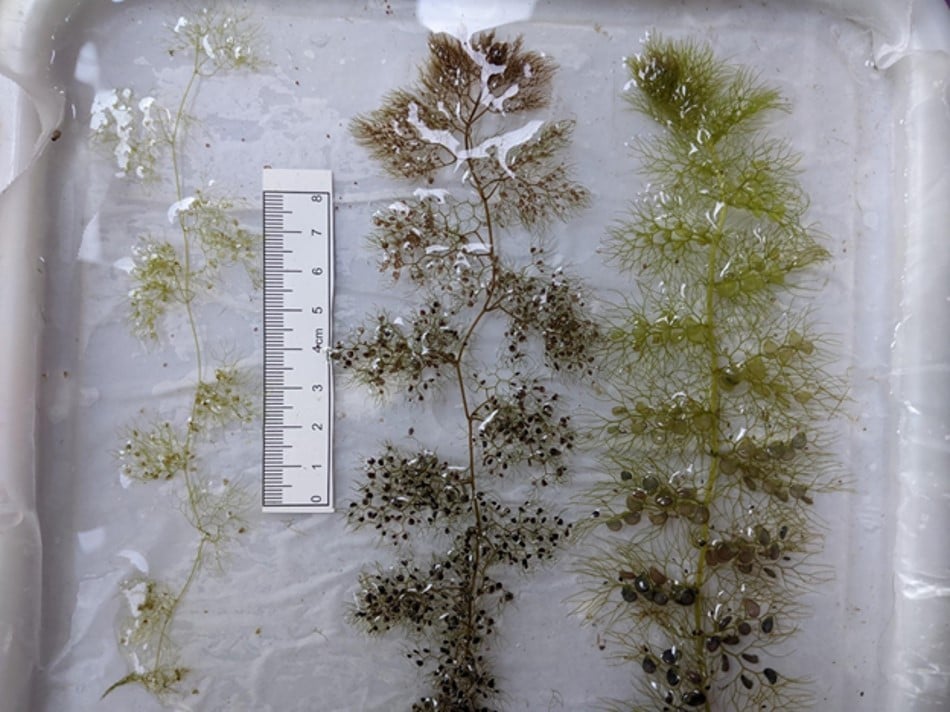
Quick Links
LSM Programs & Tools
Latest News from LSM
Forms & Data Sheets
Friend or Foe?
What to do when you find a suspicious aquatic plant
With wider awareness of the threat of invasive aquatic plants, more people are looking into their lakes and wondering what’s lurking beneath the surface. Lake Stewards of Maine (LSM) is here to help anyone, from highly trained volunteers to first-time visitors to Maine, identify any suspicious aquatic plants you may encounter and provide guidance on next steps if necessary. This service is free, easy, and open to all.
Following the procedures outlined below will help ensure the timely, accurate identification of your specimen. You may send us live material or email us a digital photo. First, however, you’ll need to collect a specimen.
Collecting a Specimen
- When collecting samples from a live lake plant, please be sure not to remove the whole plant. Snip off one or two pieces of stem from the plant (roughly 8 to 12 inches long) including as many different features as you can (flowers, fruits, leaves, etc.). Mark the plant with a buoy and on a map. In the event that your plant is invasive this will help the DEP quickly locate the infestation and take proper action.
- Keep your specimen in water in a cool place (e.g., refrigerator). This will help keep it fresh until you are ready to photograph or ship.
Send us a Plant Specimen
- Contact LSM – The staff is often out of the office during the summer, and it is important that someone be here to receive and process your plant properly.
- Package your plant – Put your sample in a resealable plastic bag. Include some water to cushion it during shipping. Be sure to seal the bag tightly. Place the bag in a small box with enough packing material to prevent movement.
- Include a Suspicious Plant Form – The form can be downloaded If you have any questions about filling out the form, call us at 207-783-7733.
- Ship your specimen – Plants should be shipped early in the week. Plants mailed too late may arrive on Saturday, when no one is here to process them.
Send us a Digital Photo/s
In order to accurately identify a plant from a photograph the image must be clear and show the greatest amount of detail possible. Good lighting must be adjusted to minimize glare. Several photos, one showing the entire plant specimen, others detailing individual features, may be needed.
IMPORTANT: Depending upon the plant, we may need to see the physical specimen, so please do not discard it until you hear from us. (Be sure to keep it fresh as described above.)
- Taking your photo/s:
- Float the plant in a tray of water long enough to stretch the sample out fully, with enough water for the plant to float freely. The tray bottom should be white (or clear and placed on a white surface).
- Gently clean off any attached debris from your specimen.
- Put something in photos to show scale e.g., a ruler or coin.
- Take a high resolution digital picture.
- If possible, take close-ups of specific features, such as individual leaves, a single whorl of leaves, flowers, fruits or other structures.
- Submitting your photo/s – Send the image/s by email to stewards@lakestewardsme.org. Write “Plant ID” in the subject line. Include the following information in the body of the message: your name and contact info; waterbody name and town; date the plant was collected.
- Documenting your submission – Log on to the LSM website and complete an online Suspicious Plant Form. This will alert LSM’s staff to the fact that you have submitted photos via email, and provide us with the information needed to record your find in the statewide aquatic plant database.
If you ever have any questions regarding submitting a suspicious plant, always feel free to contact the LSM at 207-783-7733.
